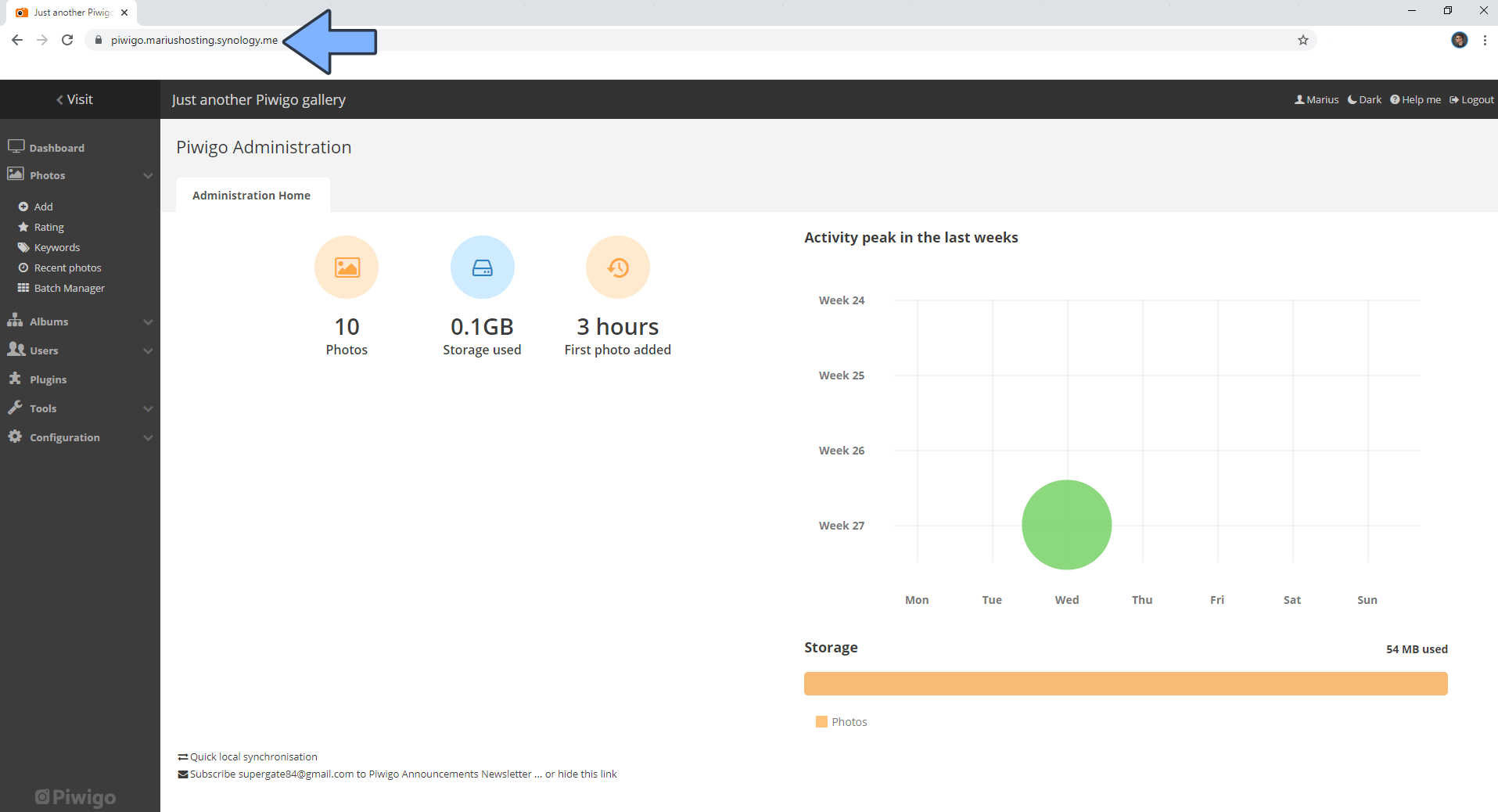
Piwigo is a photo gallery software for the web that comes with powerful features to publish and manage your collection of pictures. Piwigo is open source and is designed for organizations, teams and individuals. In this step by step guide I will show you how to install Piwigo on your Synology NAS using Docker. Note: Piwigo needs a NAS with AVX support.
STEP 1
Please Support My work by Making a Donation.
STEP 2
Install Portainer using my step by step guide. If you already have Portainer installed on your Synology NAS, skip this STEP. Attention: Make sure you have installed the latest Portainer version.
STEP 3
Go to File Station and open the docker folder. Inside the docker folder, create one new folder and name it piwigo. Follow the instructions in the image below.
Note: Be careful to enter only lowercase, not uppercase letters.

STEP 4
Now create three new folders inside the piwigo folder that you created at STEP 3 and name them config, db, gallery. Follow the instructions in the image below.
Note: Be careful to enter only lowercase, not uppercase letters.

STEP 5
Log into Portainer using your username and password. On the left sidebar in Portainer, click on Home then Live connect. Follow the instructions in the image below.

On the left sidebar in Portainer, click on Stacks then + Add stack. Follow the instructions in the image below.

STEP 6
In the Name field type in piwigo. Follow the instructions in the image below.
services:
db:
image: mariadb:11.4-noble #LTS Long Time Support Until May 29, 2029.
container_name: Piwigo-DB
hostname: piwigo-db
security_opt:
- no-new-privileges:false
volumes:
- /volume1/docker/piwigo/db:/var/lib/mysql:rw
environment:
TZ: Europe/Bucharest
MYSQL_ROOT_PASSWORD: piwigo
MYSQL_USER: piwigouser
MYSQL_PASSWORD: piwigopass
MYSQL_DATABASE: piwigo
restart: on-failure:5
piwigo:
image: ghcr.io/linuxserver/piwigo:latest
container_name: Piwigo
healthcheck:
test: curl -f http://localhost:80/ || exit 1
environment:
PUID: 1026
PGID: 100
TZ: Europe/Bucharest
volumes:
- /volume1/docker/piwigo/config:/config:rw
- /volume1/docker/piwigo/gallery:/gallery:rw
ports:
- 8633:80
depends_on:
db:
condition: service_started
restart: on-failure:5
Note: After you paste the code above in the Web editor, change the value for TZ. (Select your current Time Zone from this list.)
Note: After you paste the code above in the Web editor, change the value numbers for PUID and PGID with your own values. (Follow my step by step guide on how to do this.)

STEP 7
Scroll down on the page until you see a button named Deploy the stack. Click on it. Follow the instructions in the image below. The installation process can take up to a few minutes. It will depend on your Internet speed connection.

STEP 8
If everything goes right, you will see this message at the top right of your screen: “Success Stack successfully deployed“.

STEP 9
🟢Please Support My work by Making a Donation. Almost 99,9% of the people that install something using my guides forget to support my work, or just ignore STEP 1. I’ve been very honest about this aspect of my work since the beginning: I don’t run any ADS, I don’t require subscriptions, paid or otherwise, I don’t collect IPs, emails, and I don’t have any referral links from Amazon or other merchants. I also don’t have any POP-UPs or COOKIES. I have repeatedly been told over the years how much I have contributed to the community. It’s something I love doing and have been honest about my passion since the beginning. But I also Need The Community to Support me Back to be able to continue doing this work.
STEP 10
The installation process can take up to a few seconds/minutes. It will depend on your Internet speed connection. Now open your browser and type in http://Synology-ip-address:8633 Select your Default gallery language then add the following data:
- On the Host field type in: piwigo-db
- On the User field type in: piwigouser
- On the Password field type in: piwigopass
- On the Database field type in: piwigo
- On the Database tables prefix type in: piwigo_
Add your own username, password and email then click Start installation. Follow the instructions in the image below.

STEP 11
Click visit the gallery. Follow the instructions in the image below.

STEP 12
Click Deactivate this message. Follow the instructions in the image below.

STEP 13
At the top right of the page click Admin to access the Administration Dashboard. Follow the instructions in the image below.

STEP 14
Create new albums then uploads your Photos. You can also switch the administration dashboard to Dark Mode. Follow then instructions in the image below.

STEP 15
Your Piwigo instance at a glance!

Enjoy Piwigo!
If you encounter issues by using this container, make sure to check out the Common Docker issues article.
Note: If you want to run the Piwigo container over HTTPS, check How to Run Docker Containers Over HTTPS. In order to make Piwigo work via HTTPS, it’s mandatory to activate WebSocket.

Note: Can I run Docker on my Synology NAS? See the supported models.
Note: How to Back Up Docker Containers on your Synology NAS.
Note: Find out how to update the Piwigo container with the latest image.
Note: How to Free Disk Space on Your NAS if You Run Docker.
Note: How to Schedule Start & Stop For Docker Containers.
Note: How to Activate Email Notifications.
Note: How to Add Access Control Profile on Your NAS.
Note: How to Change Docker Containers Restart Policy.
Note: How to Use Docker Containers With VPN.
Note: Convert Docker Run Into Docker Compose.
Note: How to Clean Docker.
Note: How to Clean Docker Automatically.
Note: Best Practices When Using Docker and DDNS.
Note: Some Docker Containers Need WebSocket.
Note: Find out the Best NAS Models For Docker.
Note: Activate Gmail SMTP For Docker Containers.
This post was updated on Wednesday / December 31st, 2025 at 1:27 PM
